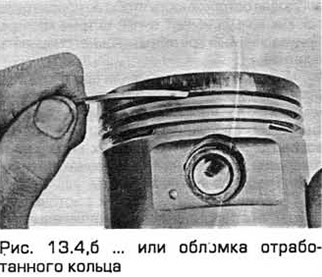Note: Before repairing, you need to make sure that you can purchase spare parts (see paragraph 1 of this chapter). If you don't have any of the spare parts, contact your dealers or engine rebuilders.
1. Before carrying out the control, the units of the connecting rod and piston groups must be cleaned and the piston rings removed from them. The working surfaces of the piston rings must be polished, without carbon deposits (which indicates poor sealing, as a result of which gases during combustion break through the ring), and there should be no wear on the top and bottom surfaces of the rings. The end gaps of the rings must be clean, without carbon deposits. At the same time, if they look like polished, then the gap in the ring is too small. All rings, including the oil ring sections, should turn freely in the grooves, but the axial play of the rings in the grooves should be small. If the rings look good, then they can be reinstalled on the pistons during assembly. Check ring end clearances (when the ring is in the non-worn zone of the cylinder), as indicated in par. 16. If any of the rings is worn or damaged, or if its end clearance exceeds the regulated one, then the entire set of piston rings must be replaced.
Note: It is common practice to replace piston rings during repairs. Do this if you can purchase a set of rings separately from the pistons. Otherwise, when following these procedures, be careful not to break or damage the rings, and also mark them so that they can be installed in their grooves during assembly.
2. Using a piston ring extractor, carefully remove the rings from the pistons. Be careful not to notch the pistons. Mark each ring on its top surface so that it fits into place when reassembling. Be careful, piston rings are very sharp! If you do not have a tool for removing rings, then they can be removed by hand.
Do it yourself
If you don't have a piston ring extractor, you can remove them by hand. Carefully spread the ends of the rings and remove them upward through the piston crown. To prevent the track from falling into empty grooves, use 2-3 used feeler gauges.
3. Scrape off the carbon deposits on the piston crown. After completing the rough cleaning, clean the bottom with a wire brush or a piece of fine sandpaper.
4. Remove carbon deposits from the piston grooves using a special tool or a piece of used ring (see fig. 13.4, a, b). To do this, break the ring in half, being careful not to cut yourself, as the rings have very sharp edges. When removing carbon deposits, be careful not to scratch the piston.


5. Immediately after removing carbon deposits, wash the parts of the connecting rod and piston group in kerosene or another suitable solvent, and then dry thoroughly. Check the oil return holes in the piston grooves and the oil holes in the lower ends of the connecting rods and make sure they are not clogged.
6. If the pistons and bores are not damaged or significantly worn, and the cylinder block does not need to be bored, then the pistons can not be replaced. Piston wear usually manifests itself in the form of uniform (piston height) wear of rubbing surfaces and a slight weakening of the upper ring in its groove.
7. Carefully inspect the pistons for cracks in the skirt areas, piston pin bosses and between the ring grooves.
8. Check for scratches and scuffs in the areas where the skirt is pressed against the cylinder walls, for bottom burnouts, and for burns along the edges of the bottom. The presence of scratches and scuffs on the skirt may indicate that the engine may have been overheated and / or a violation of the combustion mode of the mixture, accompanied by a high temperature. Carefully check the cooling and lubrication systems. The presence of burn marks on the side surface of the piston indicates a breakthrough of gases. Burnouts of the bottom or burns along its edges may indicate an incorrect combustion mode (early ignition or detonation). If any of the above symptoms of malfunctions are found, their causes must be identified and eliminated. Otherwise, damage will occur again. Causes of malfunctions can be: incorrect ignition/fuel injection timing, intake air line leaks, incorrect air-fuel ratio, or a malfunction in the exhaust gas recirculation system.
9. Pitting of the piston indicates that coolant has entered the combustion chamber and/or crankcase. Eliminate the causes of malfunctions, otherwise they will occur again after the engine is reassembled.
10. Check up piston backlash concerning a rod, rocking the piston and a rod in opposite directions. If the play is noticeable, then this indicates excessive wear that needs to be eliminated. Connecting rod and piston groups must be transferred to specialists for processing.
11. Do not try to separate the pistons from the connecting rods, even if you have replacement parts. This work should be entrusted to dealers who have special equipment for heating, pressing, etc., necessary for this work. If the connecting rod and piston groups are subject to such repairs, then it is necessary to check whether the connecting rods are bent or twisted, since such defects can only be corrected by an engine repair specialist.
12. Check up rods on presence of cracks and other damages. Temporarily remove the connecting rod bearing caps and old bearings. Clean the connecting rod and cap cradles and check them for nicks and scratches. After checking the pistons, replace the old liners. Replace the covers and tighten the bolts by hand.
Visitor comments